The iPhone 4 Redux: Analyzing Apple's iOS 4.0.1 Signal Fix & Antenna Issue
by Brian Klug & Anand Lal Shimpi on July 15, 2010 12:28 PM EST- Posted in
- Smartphones
- Apple
- iOS 4
- iPhone 4
- Mobile
In case you haven’t noticed, the iPhone 4’s antenna design has come under considerable scrutiny. In our iPhone 4 review, we investigated the iPhone 4 antenna and came to two conclusions. First, that iOS 4 was displaying signal bars in an overly optimistic manner, compressing the dynamic range of possible signal bars users can see. Second, we identified a worst case signal drop of around 24 dB when the iPhone 4 is cupped tightly in the left hand, covering the black strip and possibly detuning the antennas and adding additional attenuation from the presence of the hand.
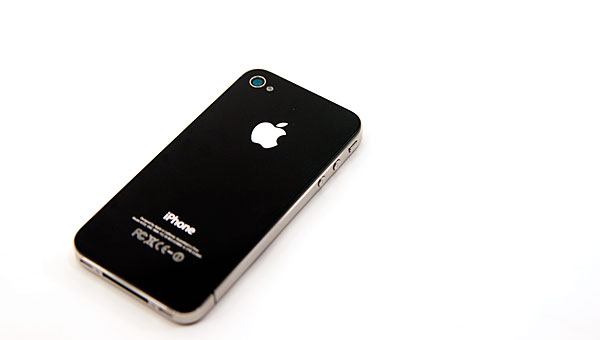
Since those initial measurements, we’ve been working tirelessly to both characterize the problem, fully understand the mechanisms behind it, and report on a number of possible solutions.
The Bars Have Changed
On July 2, Apple released a letter noting that the formula used in iOS 4.0 to calculate how many bars are presented for each signal strength is “totally wrong.” This mirrored our conclusions that the effects of the signal drop were exacerbated in part by the way the iPhone visualizes signal strength - the dynamic range is compressed so much that the 24 dB drop from cupping the phone without a case could make all the bars go away.
They went on to promise that in a future software update they would make bars 1, 2, and 3 taller, and make the bars more “accurate” by displaying 2 bars fewer in certain circumstances.
iOS 4.1 beta rolled around yesterday, and we immediately dove in to find out just how much the bar to signal strength mapping has changed. Update: iOS 4.0.1 final just came out this afternoon and we finished preliminary testing. The signal strength mapping algorithms are identical to the 4.1 beta. The findings in this article apply to 4.0.1 as well as the 4.1 beta.

After updating our devices to the iOS 4.1 beta (and 4.0.1) and making sure our little trick to show signal strength in dBm instead of bars still worked, we set off. Remember last time how I said I drove around town all day with iOS 4.0, testing the phone, and recording signal strength and how many bars were being shown? You guessed it - another update, another evening of driving around. Anand and I did quite our fair share of moving around to get a complete picture of what the new cutoffs are.
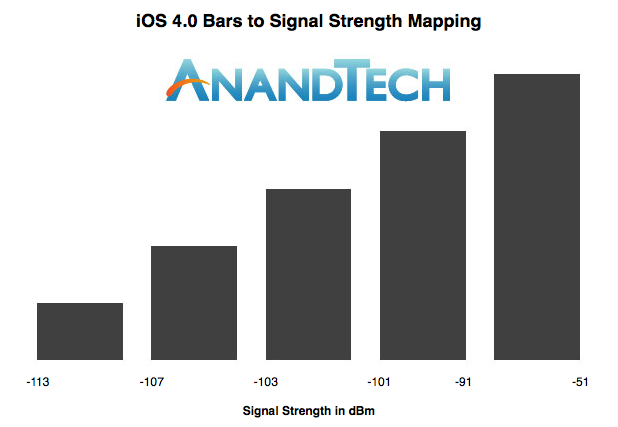
Old Bars
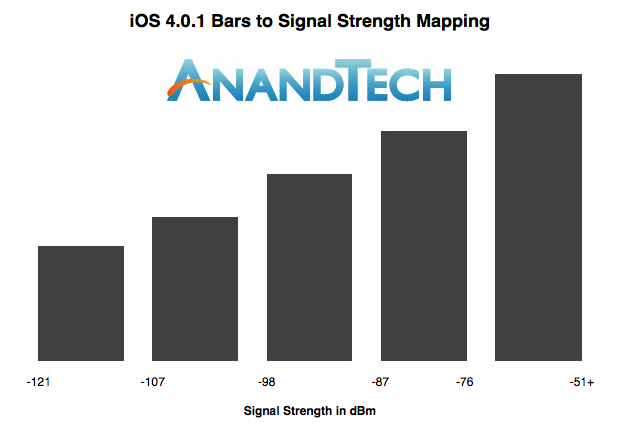
New Bars
The results are conclusive - Apple has dramatically changed the signal strength to signal bar mapping in iOS 4.0.1 and the iOS 4.1 beta, making the dynamic range not only much broader, but the range values for each bar much wider. The range of signals that correspond to bars three and four are the same width, and bar two is only slightly less.
The cutoff value for two bars to one bar remains the same, but every other value has increased. The result is that the worst case drop of 24 dBm no longer makes all the signal bars disappear, but rather two.
AnandTech reader Mike Escoffery, Director of Design and User Experience at Media Platforms, created his own diagram to help compare the old and new way of iOS signal strength reporting:
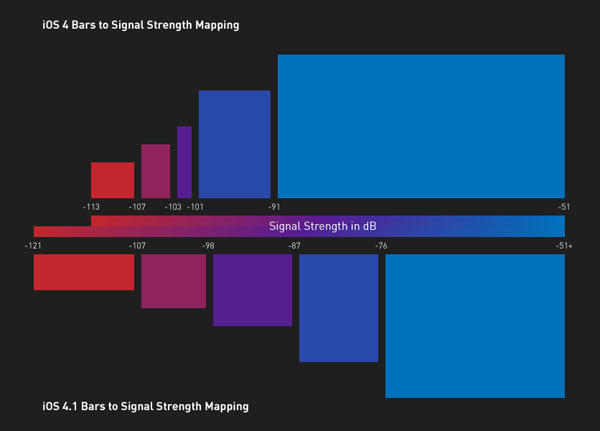
As you can see the old way (top) put far too much weight into the 5th bar of signal. Apple's new approach not only splits it up more reasonably between the 4th and 5th bar (still non-linearly keeping you in the 5th bar if possible) but also extends the range of the lower bars.
This change actually presented itself in our numeric signal strength reports - there’s more dynamic range in these numbers too. Previously, the absolute lowest value any iPhone would report was -113 dBm. With iOS 4.0.1/4.1, the value is now a shockingly low -121 dBm. In the iPhone 4 review, I talked a lot about how although the phone is prone to dropping signal from being held wrong, it was measurably more sensitive in weak signal areas. I was shocked that calls and data worked seemingly unfazed at -113 dBm. It seems as though this increased 8 dBm of range below -113 dBm was meant to show really how much more sensitive the radio stack is - it undeniably is more sensitive. Both Anand and I were able to hang onto calls all the way down at -121 dBm.
We’ve also included a comparison to how the latest version of Android displays signal bars from GSM or UMTS networks below. Thankfully, this didn’t require driving around town all day but rather inspecting the latest version of the Android source code from Google’s own repositories. Android uses an ASU value to compute signal strength, which isn’t anything more than a remapping of dBm to a sane value that’s a bit easier to interpret.
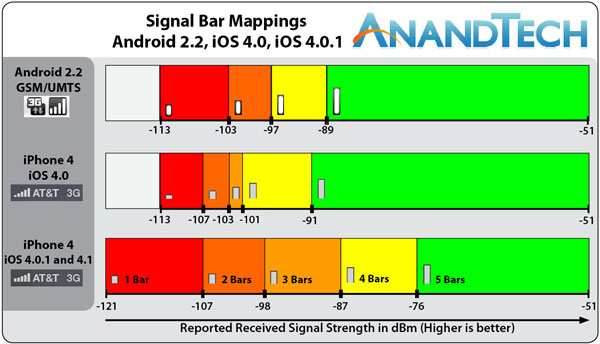
Apple’s mappings have gone from having probably the most compressed dynamic range among handset vendors to less compressed than Android.
While the software update obviously does not and cannot address the design of the antenna itself - or make the drop from holding the phone any less - it does change the way the issue is perceived among users. The result is that most iPhone users will see fewer bars disappear when they hold the iPhone 4 in a bare hand. The side effect is that the iPhone now displays fewer bars in most places, and users that haven’t been reporting signal in dBm will time see the - perhaps a bit shocking - reality of locations previously denoted as having excellent signal.
Interestingly enough, Apple has indeed changed the heights of bars 1, 2, and 3. They’re taller, and the result is that the relative heights are no longer linear, but rather a tad exponential looking. It’s a mind trick that Apple no doubt hopes will make the signal look better. If the bars are taller, they must denote stronger signal, right?
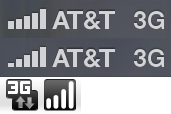
From top to bottom: iOS 4.1, iOS 4.0, Android 2.2
The reality is that Apple likely wants to deflect at least some of the initial backlash AT&T will face for reporting the signal bars without any concessions. Concessions that used to make coverage look better than it really is. Regardless of how tall the bars are, there are still going to be fewer of them virtually everywhere. Interestingly enough, while bars 1 and 2 are the most changed, their respective cutoffs are virtually unchanged.
While I was testing iOS 4.0.1, I told Anand that the signal reporting lie that started with the iPhone 3G had been removed entirely. That iOS 4.0.1 would potentially show the reality of AT&T’s coverage to iPhone users. With 4.0.1 users looking at signal bars will get a much more realistic view of how signal is changing.
We tested the iOS 4.1 beta on iPhone 3GSes as well, and found the mappings to be the same there as well.










146 Comments
View All Comments
Brian Klug - Thursday, July 15, 2010 - link
Stokestack,So I don't think I elaborated enough on how Android's implementation of the signal bar visualization cutoffs mirror standard industry practice - practice which like you say shows just how tolerant the digital system is to noise.
You're entirely right, there's a large range of bars that give you essentially full service. In fact, with the iPhone 4 it seems fine down to maybe -100 dBm.
So there are really two schools of thought here:
Option 1: The range could be compressed to show when signal is essentially good (we're between -100 dBm and -51 dBm), or bad (below -100 dBm) - this is basically what Apple used to be doing.
Option 2: Distribute the cutoffs evenly (in dBm, not mW of course) so that signal drops are reported in an even, perhaps linear fashion as suggested by the bar heights themselves. This is the route that Apple has taken with iOS 4.1/4.0.1.
Obviously the reason they've implemented Option 2 is so that the drop doesn't make all the bars disappear. Previously, if you were right above the 4 bar cutoff, and you gripped it tightly in a bare hand, all the bars went away. It made the problem inconsistent and led people to think some devices were affected while others weren't. That's the perception problem, which the bar changes do mitigate.
The other problem is the drop itself, which nothing short of hardware changes/modifications will change.
-Brian
rs1 - Thursday, July 15, 2010 - link
Holding Apple accountable for fixing their bugs should be the only thing required to mitigate the problem. There should be no need to resort to things like tape and gloves.Snotling - Thursday, July 15, 2010 - link
If I understand your statement, you apparently believe that blame and lawsuits are superior to experimentation and knowledge.The original article was cited in many other media and probably played an important role in getting the truth out there and help put an end to this issue faster.
Douglas Adams, through one of his characters said: "I would rather be happy than right anyday"
This is the king of wisdom of which your comment was deprived.
rs1 - Thursday, July 15, 2010 - link
No, you assume too much. Experimentation and knowledge are great, they just don't substitute for holding the responsible-party responsible. My point is just that if Apple does the right thing, owns up to their mistake, and fixes it, there's no need for users to invest their own time and money into fixing someone else's problem. And if Apple does that, then there is no need for lawsuits of any kind.If people want to discover what kind of hacks and workarounds are available to fix the issue manually, then good for them. Most people, however, would likely prefer to have the manufacturer fix the defective product properly, so that they don't need to spend their own resources doing so. There is, after all, more valuable knowledge that people could be seeking than how to fix a phone that Apple broke. Especially people as clever as Anand and Brian.
dypeterc - Thursday, July 15, 2010 - link
as the article states, "Whether or not the antenna design manifests itself as an issue really depends on AT&T’s coverage where you’re using the phone."just because iPhone 4 has a higher attenuation, doesn't mean there's a problem.
at&t needs to get its act together and roll out better coverage.
in addition, if you don't like the fact that it has a high attenuation, you can always return it. everyone is still within the 30-day grace period.
Tanker10a - Friday, July 16, 2010 - link
dypeterc,I could not agree more with your comments. I am currently using the 32GS iPhone and I am absolutely frustrated with AT&T with this coverage issue. From my backyard, I am flanked by two 2G (EDGE) antennas that are approximately 10 miles away according to AT&T Consumer Service department and after screaming at them last Sunday; they still could not solve my problem. It took three to four phone calls plus waiting time in order for them to identify that those towers cannot deliver 3G signals. Contacted AppleCare and they told me to reset my iPhone (never mind the fact that I have done that since iOS4 was deployed)... I think that regardless what kind of phone that you throw at these towers, you will not get the coverage that you are paying for. Truthfully, the iPhone operates great when it is in the company of a Wi-Fi device or 3G. I have received AWESOME coverage in the Carolina Great Smokey mountains than I do from my backyard.
Bottom line, AT&T needs to own up to this problem.
As far as the Antenna is concerned, I think Apple is stuck with the positioning of its location due to FCC regulations... And, this is no different than grabbing your typical radio antenna and to experience a signal drop...
leexgx - Thursday, July 22, 2010 - link
i have not seen any other mobile company follow the FCC rule like apple hasagain simple fix buy the bumper case or case like it (none conductive)
Snotling - Thursday, July 15, 2010 - link
Actually, it is Anand and Brian's job to do those kind of experiment so that we do not have to, and so that we know precisely what kind of product is put on the market, what are their capabilities and if there is a huge amount of hype over something: to translate it to rational and factual information, so that we are not prey to basic marketing evil and limited to the information available on the shelf sticker at best buy.this is exactly what tomshardware stopped doing so I'm doubly happy that Anandtech sticks to it.
so if wearing a glove to hold a phone can prove a point please, do it before I spend my money on the phone because I want to know this.
jonup - Thursday, July 15, 2010 - link
If I understand your statement, you apparently believe that pulling a latex glove out in public and freaking everyone around you every time you need to make a phone call is unacceptable?aj28 - Thursday, July 15, 2010 - link
This whole thing is ridiculous. You know what else doesn't work well when tightly cupped in your left hand? Asymmetrical mice.